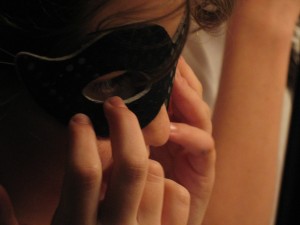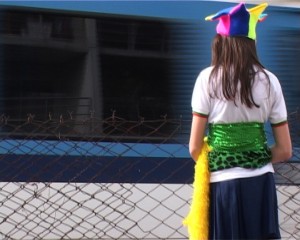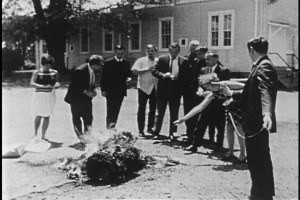Between Women: The Filmworks of Lynne Sachs
an interview published by OTHERZINE
http://www.othercinema.com/otherzine/?issueid=24&article_id=115
by Molly Hankwitz Cox
11 Sep 2010
In my twenty year relationship as audience to Lynne Sachs’ filmworks, I have always admired her amazing ability to connect the very personal, physical relationship of ‘selfhood’ to film and film history and to collage a variety of complex themes into one complete film, often with challenging ambiguity and open endedness.
I first heard of Sachs as part of an active cadre of “downtown” avant-garde feminist filmmakers working in New York City, who were –in the late eighties–reading the new radically feminist theory of Helene Cixious, Luce Iriguay, and Julia Kristeva and who had strong links to San Francisco’s experimeantl feminist film scene. These women were busily exploring the great personal and political themes of, the ‘then’, feminist culture: gender, body, sexuality and language–how to develop womens’ language. Later, I had the good fortune to meet Sachs in person at Other Cinema.
The recent West Coast retrospective of Lynne’s work demonstrated just how far-reaching, intimate, and astute her work can be and given my personal connection to that past, radicalized period of feminist culture, and the admiration I have for Lynne and her work, I decided to ask her about some of the influences, opinions and practices she’s formed over a nearly thirty year career.
…
Molly Hankwitz Cox: Drawn and Quartered (1987) and House of Science (1991) revolve around your own body. House of Science also radically investigated the male dominance in consciousness of the female body, as it enshrouds personal understanding of female selfhood and the incompleteness of this picture. You may say that it was about your own preparation for becoming a mother or exploration of self, but I’ve often wondered if you anticipated how meaningful that film would be – has been – to your audience?
Lynne Sachs: In the late 1980s and early 90s, my deepest concerns as a woman and an artist revolved around issues of gender and sexuality. I was in a reading group with a group of very intellectual and creative women – including Kathy Geritz ( film curator at the Pacific Film Archive) and Peggy Ahwesh, Nina Fonoroff, Jennifer Montgomery, Lynn Kirby and Crosby McCloy (all filmmakers) – and we were reading some of the most powerful, eye-opening literature I had ever experienced. For each of us, the discovery of the expansive, rigorous and playful essays of French writers Luce Irigeray (Speculum of the Other Woman) and Hélène Cixous (The Newly Born Woman) completely changed our sense of language and the body.
Both my films Drawn and Quartered and The House of Science: A Museum of False Facts were informed by these radical texts and the discussions we had as we sat in one another’s apartments drinking tea and eating. I think these films express my own reckoning with the sense of fragmentation I felt throughout my adolescence, my desire to be removed psychically from the me that was a body. I appear naked, briefly, in both of these movies as well as in the later Which Way is East (1994). For a girl who hated to go bra shopping because she would have to undress in public, these movies were minor watersheds, I guess. Now that I have lived through two childbirths, my daughters Maya and Noa claim I am too comfortable taking my clothes off wherever I feel like getting undressed.
MH: Ha. (Smiles) Feminist filmmaking unmasked the camera as spectator and the power that gave us to explore our collective disavowal of physicality was huge. But times have changed since then and discourse on spectatorship is less pronounced or fresh. In Wind in Your Hair /Con viento en el pelo (2010) you expand your vision well beyond your own camera and/or any use of archival footage. You’ve enlisted a number of super8 filmmakers/students from Buenos Aires and Sofia Gallísa in New York, for example. Are you simply casting your net wider by being more inclusive — developing more of an international and global film community in your work?
LS: Ever since I first started making films, I have resisted the traditional pyramid-shaped production hierarchy of a director and her crew as well as the model of the director and her obedient cast of actors. On both fronts, I wanted to develop a more porous relationship in which we would all listen and learn from each other. Watching Yvonne Rainer’s Lives of Performers really rocked my world; she included these frank interior dialogues in a piece that ostensibly looked like a dance documentary. The levels of perception that she created were astounding.
MH: It’s true. Yvonne’s films are so complex in that way. Just great. She deconstructs without pretension.
LS: When I made the short film Still Life With Woman and Four Objects (1986), I asked my actress to bring a prop (one of the four objects) that would reveal something about her thinking and shake things up a bit. She brought a black and white photo of the revolutionary feminist Emma Goldman and things were never the same again. More recently, one of the key participants in my film was an Argentine psychoanalyst who came to our set during the nightmare scenes to help us infuse this dream with another psychological dimension I didn’t think I had access to. Her training was critical to the shaping of the mise-en-scene. Then there was the bilingual aspect of (Con viento en el pelo). I didn’t speak a word of Spanish until I started showing my films in Argentina in 2007 and a year later decided to spend two months in the city making the film. Integrating a language I was just beginning to speak, read and understand problematized the whole process in such interesting and dynamic ways. I often had to release the presumed power I had as director, and these moments were the times when I learned the most from the children and from the members of my crew. These kinds of fragile collaborations are vital to my way of making films.
MH: In other dialogues, you have sometimes defined two types of film–YES films, which include putting everything into the mix, allowing the maker to invent and intuit, arriving at a different place than where one began, and NO films which are “Think of a topic and carry it through” works. This categorization includes, arguably, the sensibilities of many film works, regardless of genre, and also separates modes of imagining and creating, from the end result. You suggested to Kathy Geritz that is a NO film, but when the young “actresses” invent freely (choose costumes daily, create dialogue, choose locations) in their “kingdom” isn’t this a YES dimension?
LS: It’s interesting that you bring up this Yes/No dichotomy that occurred to me about ten years ago, when I realized that there was a pattern emerging in my work, a rhythm between films that were open to changes brought by the times and films that followed a very clearly defined vision or concept. For both you and me, as mothers, we have spent the last few years of our lives using these terms as a way to define the liberties our children could have, what was allowed or at least not dangerous, and what was out of bounds. But in my artistic practice, I sometimes feel that I am too distracted, too lenient on myself and not capable of working in a more pared down, essential way. So a NO work is one that implies a discipline of the mind. , which is essentially my first narrative film, grew out of a short story by Julio Cortázar about three preadolescent girls performing by a train track. I thought it was a NO film and that I would adhere to the author’s vision rather closely. Instead, I took liberties by integrating the inner thoughts of my “actresses” and by engaging head on with the social unrest that was whirling around us in Buenos Aires during our production. Maybe the most important rules to break are the ones you impose upon yourself.
MH: touches upon the delicate transition from childhood to adolescence taking place in girls when they begin to navigate the real world. The film bears the marks of a parent’s sensitivity to this period when children learn judgment in caring for themselves, hence, personal independence and the need to protect themselves. Their fears and dreams sometimes disclose unconscious concerns with detaching from what is familiar into that which is unknown. On some level, you have expressed the primordial, parental need to fix their play to architecture, building in both your own concern, and their immature need, still, for protection. Can you comment?
LS: I really love the way you talk about a parent who wants to fix – even transform – her child’s play into architecture. If Gertrude Stein – the experimental poet and grand-dame of the mid 20th century avant-garde – had been a mother I wonder if she would have succumbed to this desire to reign in the amorphous spirit of a child. What I so love about her writing is its resistance to conventional syntax and prescribed meaning. In the language of the semiotician, she wanted to create provocative ruptures between the sign and the signified, between the way we are taught to speak (to communicate) and the way we ultimately choose to express ourselves (art). We experimental filmmakers are trying to do the same thing, not only with words, but also with images and sounds. So if you and I believe with all our hearts in the paradigm of the avant-garde, where does that lead us in terms of bringing up our children in a society with a whole set of explicit and implicit rules and expectations? Does a piece of architecture need four walls, a window and a door? Does a story need a conflict and a resolution? In my short film Atalanta: 32 Years Later (2006), I played with two different versions of the myth of Atalanta. The story is a retelling of the age-old fairy tale of the beautiful princess in search of the perfect prince. In 1974, Marlo Thomas’ hip, liberal celebrity gang created a feminist version of the children’s parable for mainstream TV’s Free To Be You and Me. Clearly, this is a classic tale with a conflict between a daughter and her father and between a young woman and the society at large. For the first time in my life, I embraced the tale in its entirety and remained true to the original structure. Let me tell you, this is not my style. My 2006 twist on the myth’s storyline was to give it an explicitly lesbian conclusion and to split the screen in two in order to show the 1974 version forwards and backwards simultaneously. While the essence of the “architecture” is still there, I celebrate “play” to its fullest. I dedicated this film to filmmaker Barbara Hammer.
(pause)
MH: You always enjoy trying out new ideas, new experiences and places, and meeting people with unique stories?
LS: I remember hearing Stan Brakhage say once that maintaining an element of play in the filmmaking process was at the very foundation of his practice. In my mind, what he was saying was that the exploration had to remain constant. I have tried to do that all of my life, and this can sometimes slow down the process because you end up letting the materials speak back to you, telling you how to make the work, sending you in directions where you feel awkward and out of your element. This way of working, however, comes out of the traditions of painting and sculpture much more than story-based moviemaking. When I find kindred spirits who want to work with the medium of film or video in this way, I naturally gravitate toward them!
MH: What drew you to Argentina? You and Mark Street, curated an Argentine experimental film program and screening. Is this how it all happened?
LS: In 2007, I took my daughter Maya to a mini-retrospective of my films in Buenos Aires, met some Argentine filmmakers and was immediately convinced that I wanted to return not only to shoot a film but also to begin learning Spanish. While Mark and I were in Buenos Aires and Montevideo, Uruguay with our two daughters during July and August of 2008 and then again in 2009, we each collaborated with experimental makers in those cities to make new artwork. I made Wind in Our Hair / Con viento en el pelo with a Leandro Listorti and Pablo Marin, two Super 8 aficionados who probably know more about American avant-garde film than most artists in the States. They love the whole history of experimental filmmaking – Man Ray, Carolee Schneemann, Bruce Conner, Ken Jacobs, Jem Cohen, Marie Losier and more – and watch it whenever or wherever they can. In Uruguay, Mark and I introduced a group of artists to the wonders of “hand-made” film. We taught them how to make their own movies with found footage, dyes, q-tips and razors. The two of us then made a film about this workshop experience which we call Cuadro por cuadro/ Frame by Frame (2009). It’s a film about our sharing of our love of experimental filmmaking and our students’ discovery of its wonders.
MH: Other Cinema screened that film last year and I couldn’t believe I was seeing yet another Lynne Sachs film; this one such an adventure in handmade film and working with people. It was great. There are such a variety of motivations in all of your works. I’ve always admired that relaxed, almost lackadaisical editing style you have in many of your films. Its like you are offering something luscious to the audience, for us to take in, like the hostess for the experience–an invitation to participate in the way you think. You make filmmaking seem effortless. You’ve described editing yourself out of Drawn and Quartered, shot on 8mm as trying to ‘erase’ yourself, and then? re-purposing the outtakes and putting yourself back in. In Wind in Our Hair, you have a larger group collaborating and editing as you go. Could you talk about these processes, in hindsight, and how you see them having changed or not?
LS: You have such an astute way of thinking about the plasticity, shape, surface and structure of film. I really appreciate this approach to your questions because it gets me thinking about the dialog between material and concept. I actually made Drawn and Quartered with an old boyfriend, John Baker, and so the dance of images between the man and the woman and between the camera and the performers (the two of us) is a visual love poem that articulates our intimacy as well as our problems as a couple. While we are on the screen together, we are never actually in the same frame. As they say “Appearances can be deceiving.” I was still so uncomfortable with my body at the time that I initially took out my face from the movie and then, with pressure from some feminist-minded girl friends, put it right back. Since the film is made on regular 8mm film, these “cuts” (yes, this is a double entendre) show. Now, many years later I am still fascinated by how the series of images were actually photographed in a particular order; and, I am sad to see the way digital technologies obliterate the spirit of the initial chronology of shots. So you are somewhat right when you speak about and the way that it was edited. My co-editor, Sofia Gallisa, and I tried to keep the physicality of the small gauge film materials in as close to the original order as we could. In this way, it felt truer to the moment in time in which it first breathed. In my other recent film The Last Happy Day (2009) I videotaped a rather conventional headshot interview with an 85 year old woman sitting in a chair. I adored they way she talked about the past, and her candor in regards to her inability to recount something that happened long, long ago with any accuracy. She told me she could no longer distinguish between her own reality and fantasy. I tried to celebrate this poignant awareness of memory by leaving black spaces between cuts in her monolog. This formal fissure in the diagetic space upsets some people because it is a bit ugly and raw, but I think it is critical.
MH: Slight change of subject…Some of your work is about war. Instead of explaining it as a political event in an obvious way, you explain it instead from the perspective of how humanity responds to the ongoing crisis. In The Last Happy Day, a man, a distant relative, I believe, whose job it is to sort the remains of the dead is the central character. I know you were in Brooklyn –because we contacted you–during the events of September 11th. You described the ash in the sky falling near your home in Brooklyn. Is your interest in the process by which we absorb war’s atrocities, a means through which to articulate your own feelings about that horrific event? Is there a conscious connection for you there?
LS: I remember you and David contacting me from Australia soon after that day, and it meant so much to hear from you from so far away and with such compassion. A group of Bosnian artists actually wrote to me the afternoon of September 11, 2001. I, along with SF artist Jeanne Finley, had recently returned from working with these artists during a two week fellowship in Sarajevo. We were collaborating over the internet on a web art project we called The House of Drafts, 2001. Since, they had lived through the mid-1990s bombings of the Balkan wars, they were keen to convey to me that they knew how it felt to be attacked from the air. As you said earlier, this kind of international collaboration is critical to my practice – on both an artistic and an emotional level.
MH: The beauty of the Internet.
LS: In terms of The Last Happy Day, I think you are the first to see the connection between my interests in war and the human body. Even back in 1994 when I made Which Way is East: Notebooks from Vietnam, I was aware of this exchange between the physical self and the social self. As I was traveling through the Mekong Delta, just a few months after they opened Vietnam to American travelers, I wrote “I am a bone collector who knows nothing about anatomy” in my journal. Whether I am rummaging through the Twin Towers ashes that floated into our neighborhood playground (Tornado, 2001) or listening to stories about my distant relative who worked for the US Army reconstructing the bodies of American soldiers, these issues keep coming back to haunt me.
MH: Thank you so much, Lynne. I hope we can talk again soon and in more depth.
Find more on Lynne Sachs’ work at: www.lynnesachs.com
Stills from House of Science, Wind in Our Hair , and The Last Happy Day, respectively, and courtesy of Lynne Sachs.
◊
Links
Opening Doors in the Red Light District: Making Films in Buenos Aires by Lynne Sachs
Filmthreat.com review of THE LAST HAPPY DAY (Sept. 2010)
Essay by Susan Gerhard for Lynne Sachs Retrospective
Film Comment Review of Abecedarium:NYC an interactive website by Lynne Sachs (june 2010)
Last Address: an elegy for a generation of NYC artists who died of AIDS by Ira Sachs, Lynne Sachs and Bernard Blythe









